I’ll never forget the first time I watched the sun dip behind Trapani’s salt pans. There’s just something magical about that golden hour—the sky turns into a wild canvas of orange and pink, with the colors bouncing off the shallow waters.
During sunset, Trapani’s salt pans become a photographer’s dream. You only hear the gentle waves and the distant calls of birds.
But it’s not just the colors that make this place special. There’s this perfect blend of nature, history, and peace that I haven’t found anywhere else in Sicily.
The Saline di Trapani e Paceco nature reserve offers a rare chance to see flamingos and other birds right against these ancient salt pools.
My heart still jumps when I remember standing there, camera ready, as the Mediterranean light played over the water’s surface.

You get this sharp scent of salt, mixed with wildflowers, and it lingers with you long after you leave. If you want a real Sicilian moment, you really have to see this sunset for yourself.
Trapani’s Salt Pans: A Legendary Sicilian Landscape
Western Sicily has some of the most breathtaking landscapes I’ve ever stumbled across. Trapani’s salt pans create this mesmerizing patchwork of white and blue, capturing the essence of the Mediterranean coastline.
A Brief History of the Salt Pans
Salt production in Trapani goes way back to Phoenician times, around the 8th century BC. The Phoenicians saw the perfect setup here: shallow waters, strong winds, and scorching summer heat.
In the Middle Ages, people called salt “white gold” because it was so valuable for preserving food. The Arabs expanded salt production here and brought new techniques.
By the 16th century, the Spanish set up a salt monopoly and built those iconic windmills you still see today. These windmills pumped seawater and crushed salt crystals.
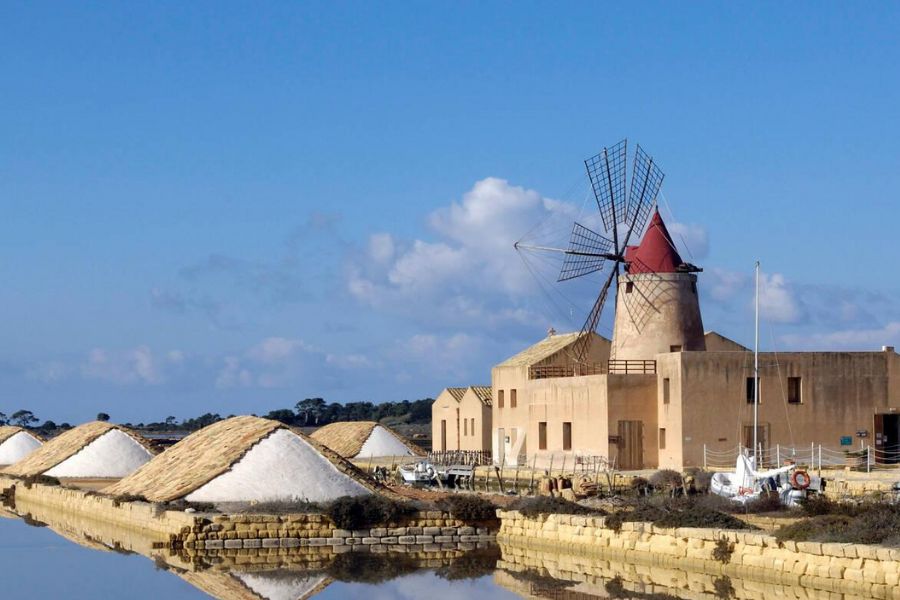
Today, salt makers stick with traditional methods. They let seawater flow through shallow basins, let it evaporate, and harvest the salt crystals in late summer.
Significance in Sicilian Culture
Trapani’s salt has shaped local cuisine for centuries. Its unique flavor shows up in all kinds of Sicilian dishes, especially seafood and capers preserved in salt.
The salt pans created a special profession—the “salinaio,” or salt worker. Families pass down these skills through generations, keeping this heritage alive.
Every year, locals celebrate the salt harvest with festivals. I once watched dancers perform right on the salt flats as the sun set—a scene straight out of a dream.
You’ll find the salt pans in Sicilian literature, poetry, and art. They symbolize perseverance, harmony with nature, and the island’s deep connection to the sea.
The Salt Pans and the Mediterranean
Trapani and Paceco’s salt pans are part of a protected nature reserve that stretches over 1,000 hectares along the Mediterranean coast. This wetland is a vital home for all sorts of wildlife.
Flamingos, the real showstoppers, add bursts of pink against the white salt and blue water. I spotted a few feeding in the shallows, sifting tiny creatures through their bills.
The Mediterranean climate really works its magic here. Hot, dry summers and light sea breezes speed up evaporation, while winter rains help reset the pans.
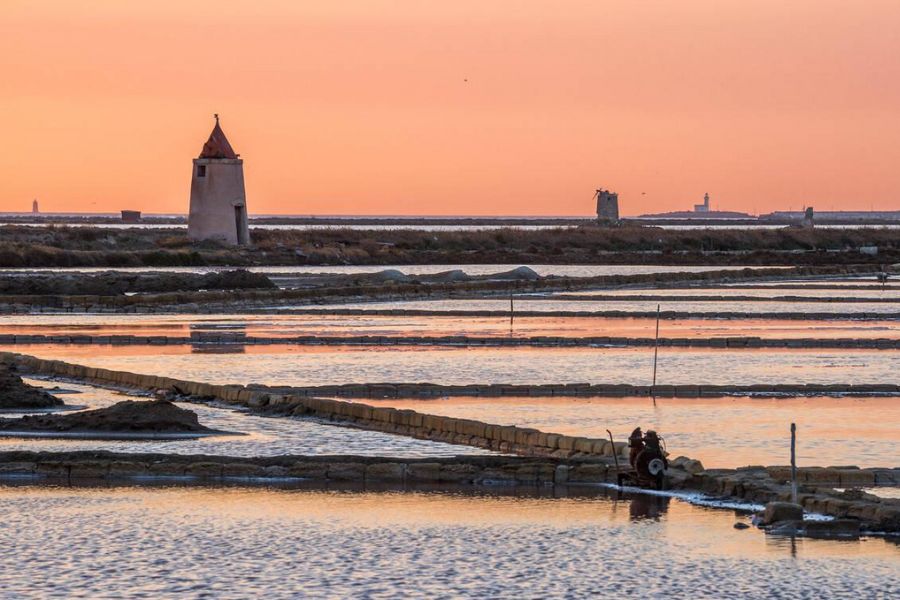
Salt from Trapani travels all over the Mediterranean. Chefs love “Sale Marino di Trapani” for its purity and minerals—it’s a staple from Marseille to Beirut.
Chasing the Sunset: Magic Hour Experiences
As the day winds down, Trapani’s salt pans turn into a mesmerizing spectacle. If you’re patient, the experience is unforgettable.
The Allure of the Golden Hour
I’ve seen a lot of beautiful places, but nothing quite matches golden hour at Trapani’s salt pans. About an hour before sunset, the sun starts casting everything in a warm, glowing light.
The whole scene pulls you in. As the sun drops toward the Mediterranean, the landscape glows with amber hues, and the salt crystals start to sparkle.
The changing light plays tricks with the shallow pools. They turn into mirrors, doubling the sky’s colors.
Locals say this is when Trapani reveals its true soul. I’d agree—it’s worth planning your whole day around catching this transformation.
Capturing Iconic Images
Sunset at the salt pans is a photographer’s playground. I like to arrive about 90 minutes before sunset to find the best spots and set up.
The windmills, silhouetted against the sky, are classic Trapani. They’re symbols of Sicily’s salt-making tradition.
Try to capture:
- Reflections in the still saltwater
- Flamingos gathering nearby
- Salt mounds that glow as the sun sets
- The texture of salt crystals up close

My favorite shots come from getting low to the ground near the water. That way, you catch both the dramatic sky and its reflection.
Best Viewing Spots
After a few trips, I’ve found some top spots for sunset magic. Saline di Trapani e Paceco is the most accessible and delivers the best views.
The Salt Museum (Museo delle Saline) has a terrace with a great vantage point. From there, you see the salt pans’ geometric patterns stretching out.
If you want a more personal experience, walk the narrow paths between the pans. You’ll feel surrounded by color, but watch out not to disturb the salt workers.
Mozia, a small island visible from the pans, adds a cool silhouette to your sunset photos.
How the Light Transforms the Landscape
Sunset transforms Trapani’s salt pans in ways that are hard to believe. What looks ordinary at midday becomes extraordinary as the sun drops.
The water shifts from clear to gold, then pink, purple, and finally deep blue as twilight falls. The colors patch the landscape and change minute by minute.
Salt crystals along the pan edges catch the light differently through sunset. Early on, they glow warm; later, they almost look red.
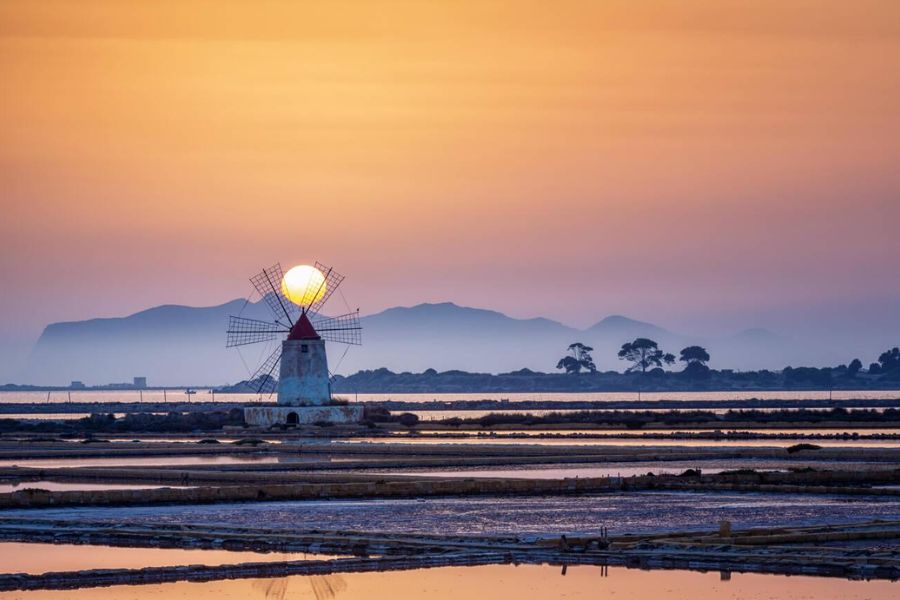
Mountains of harvested salt reflect the sky’s colors, looking like chameleons in the shifting light. Photographers from everywhere show up just to catch this display.
Planning Your Visit: Logistics and Tips
Visiting Trapani’s salt pans takes a little planning, but it’s worth it. Here’s what I’ve learned about getting there, picking a place to stay, and moving around.
Getting to Trapani from Major Cities
I was surprised by how easy it is to reach Trapani from big European cities. From Rome, you can grab a direct flight to Trapani-Birgi Airport (just under 2 hours) or fly to Palermo and drive the rest.
If you’re coming from Paris or Venice, you’ll probably connect through Rome or Milan. Naples has direct flights in summer. From places like Jerusalem or Cologne, expect a layover.

I’d suggest booking flights three months ahead, especially for May through September. Or, if you’re up for it, take the ferry from Naples—an overnight trip I really enjoyed last summer.
Where to Stay: Best Hotels
I’ve tried a few places in Trapani, but Hotel Vittoria stands out. It’s close to both the city center and the salt pans, and the rooftop terrace is perfect for sunset.
If you want luxury, check out I Mulini Resort. It’s a converted windmill with stylish rooms and a restaurant that specializes in salt-infused dishes.
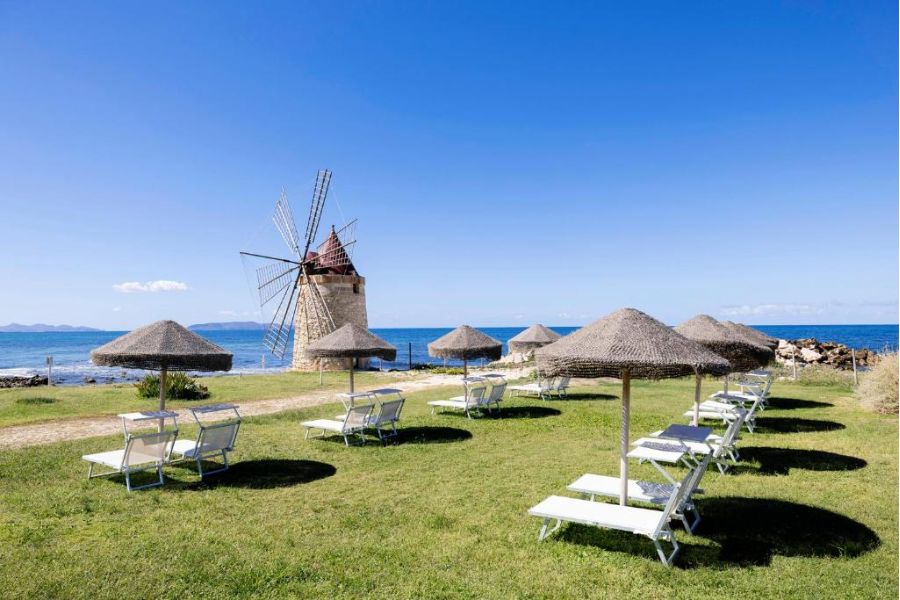
Traveling on a budget? B&B Salvatore is a solid choice, and the owner lends out bikes—ideal for exploring the pans.
Top Hotel Options:
- Hotel Vittoria – ⭐⭐⭐⭐ ($)
- I Mulini Resort – ⭐⭐⭐⭐⭐ ($$)
- B&B Salvatore – ⭐⭐⭐ ($)
Try to book 4-6 weeks ahead if you’re coming between June and September.
Navigating with Luggage and Metro Options
Trapani’s old center is charming but those cobblestones are tough with heavy bags. I learned that lesson quickly.
There’s no metro, but local buses connect the center and salt pans. Bus #21 goes by every 30 minutes. A 3-day bus pass (€12) is handy if you plan multiple trips.
Taxis are easy to find, but negotiate your fare before hopping in. I usually pay €20-25 from the center to the salt pans.
If you have mobility issues, most hotels have elevators, but double-check—some old buildings don’t. Many tour operators offer hotel pickup, which saves you from dragging luggage around.
Local Flavors and Souvenirs Near the Salt Pans
Around Trapani’s salt pans, I found plenty of culinary gems and unique souvenirs. The local flavors and shopping options really add to the sunset vibe.
Sampling Sicilian Local Cuisine
Trapani’s food tells Sicily’s story in every bite. Seafood is everywhere, with restaurants serving the day’s catch in classic styles.
Salt from these very pans seasons many dishes, giving them that local kick. Don’t miss busiate trapanesi—a spiral pasta usually served with pesto alla trapanese (a tomato and almond sauce).
Nearby street markets sell pistachios from Bronte, honey from Sortino, and almonds from Avola. I loved snacking on these while watching the sunset.

For a sweet fix, try cannoli siciliani with fresh ricotta or cassata, a sponge cake with ricotta cream. Vendors often offer samples, so you can taste before you buy.
Top Restaurants for Sunset Dining
Several spots near the salt pans serve up great food with sunset views:
Saline Culcasi isn’t just a salt producer—it’s also a restaurant where you can enjoy an aperitivo as the sun goes down. The staff are genuinely friendly.
Trattoria del Sale sits right by the pans and uses their own salt in the kitchen. Their seafood pasta really captures the local flavor.
Al Tramonto (which means “At Sunset”) is the place for dinner with a view. Book ahead if you want a terrace seat.
Wine lovers can try local Marsala wine, which pairs perfectly with the sunset and Sicilian cheeses.
Discovering Souvenir Shops
Small boutiques and artisan shops dot the area near the salt pans. Most open from 9 AM to 7 PM, but many close for afternoon siesta.
Salt itself makes a great gift. Shops sell decorative jars—some plain, some with herbs or spices. I keep a little jar on my fridge as a reminder.
Look for salt-based beauty products too. Salt scrubs, bath salts, and soaps are practical souvenirs that bring a bit of Sicilian relaxation home.
Some favorite shops:
- Sale e Sapori (Salt and Flavors)
- Bottega del Sale (Salt Boutique)
- Artigianato Siciliano (Sicilian Crafts)
Unique Finds: Ceramics and More
Sicilian ceramics are hard to resist. The bold patterns often feature lemons, pine cones, and Moorish heads—classic Sicilian symbols.
I found ceramic salt containers painted with scenes from the salt pans. They’re practical and beautiful, combining two local specialties.

Other cool finds:
- Hand-woven baskets like those used in salt harvesting
- Mini windmills modeled after the real ones
- Bottles of Marsala wine with custom labels
Local artisans also work with coral, a Trapani tradition. Small coral jewelry or decorative pieces make elegant, maritime-inspired keepsakes.
If you want something really unique, check out items made from salt crystals—lamps and decorations that shimmer just like the salt pans at sunset.
Beyond Trapani: Inspiring Sicilian and Mediterranean Destinations
Sicily has so many treasures waiting beyond Trapani’s salt pans. Nearby regions can surprise you with moments that feel just as magical.
The Mediterranean coastline? It stretches on and on, tempting travelers who crave both culture and natural beauty.
Exploring Marsala and Etna
When I visited Marsala, just south of Trapani, I stumbled into a place that felt like a hidden gem. The town’s famous fortified wines and those coastal views really left an impression.
Some of the wine cellars go back centuries. I loved how tastings here connect you straight to the region’s deep history.
Mount Etna, though, is a whole other world. This volcano—the most active in Europe—shapes a wild, almost surreal landscape. It honestly changed how I see natural wonders.
The black volcanic soil around Etna grows some truly special wines. There’s this unique mineral taste you can’t really find anywhere else.
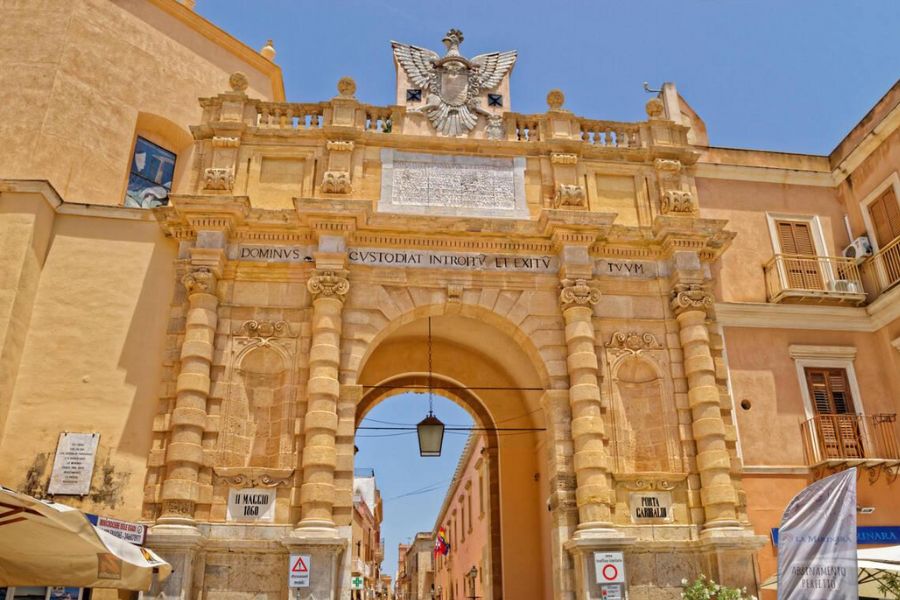
Hiking up Etna’s slopes is something I’ll never forget. The views across eastern Sicily are just breathtaking.
If you’re thinking about exploring the craters and lava fields, I’d say go with a guide. You get the story behind the volcano’s impact on local culture and farming, plus you stay safe.
Travel Ideas: From Sardinia to the Rhine
Sardinia totally won me over with its emerald waters and rugged coastline. Costa Smeralda’s beaches? Honestly, they can hold their own against any in the world.
The sand is powdery white, and the Mediterranean water is so clear it almost doesn’t seem real.
If you want a change of pace, the Rhine River valley stands out. Castles dot the landscape, and it feels light years away from Sicily’s sun-soaked shores.

Vineyards line the dramatic riverbanks and produce some of the best Riesling wines I’ve tasted.
Mediterranean Island Hopping:
- Sardinia: Pristine beaches and ancient nuragic ruins
- Sicily: Archaeological wonders and volcanic landscapes
- Malta: Medieval architecture and crystal blue lagoons
River cruising along the Rhine lets you unwind while seeing a bunch of destinations—no need to pack and unpack every day. The terraced vineyards and medieval towns almost look too perfect, like they belong on a postcard.
Memorable Encounters: Richard and the Local Scene
Meeting Richard—a writer from abroad who put down roots in Sicily twenty years ago—completely changed how I saw the island.
He pointed me to authentic experiences I would’ve missed if I’d stuck to the guidebooks.
Richard took me to meet local fishermen. They still fish with the same techniques their grandparents taught them.
Thanks to his network, I ended up at a family dinner. Three generations cooked up seafood they’d caught that very morning.
The local scene pulses with life far from the tourist crowds. Neighborhood festivals pop up, celebrating patron saints with food, music, and this contagious sense of community.
Richard nudged me toward tiny wineries, where families craft small batches of wine you’ll never find outside Sicily.
With these connections, Sicily stopped feeling like just another destination. Instead, it started to feel a bit like home—at least for a while.
Locals shared stories about how their communities keep shifting. Younger folks try to balance old traditions with whatever’s coming next.

